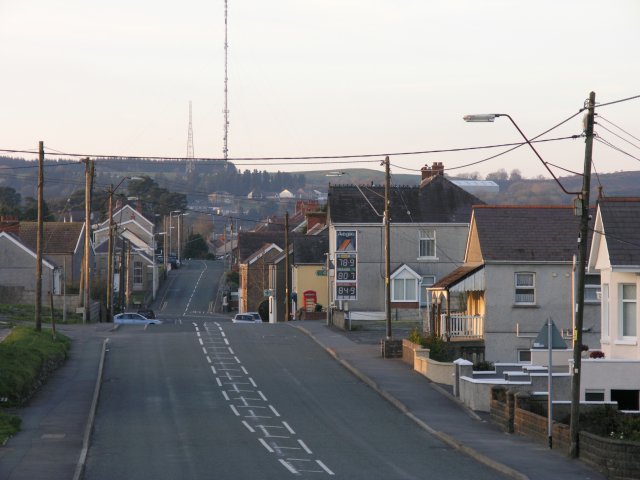|
Calfaria, Penygroes
Calfaria is a Baptist chapel in the village of Pen-y-groes, Carmarthenshire, Penygroes in the community of Llandybie, near Ammanford, Carmarthenshire. Services at Calfaria were conducted in the Welsh language until recently but are now bilingual. History Calfaria was founded in 1896 by Baptists who worshipped at other chapels in the vicinity and miners who had migrated to the areas to work at the Emlyn and Caerbryn collieries. They originally met in each other's homes and then in a small ramshackle building, later known as the (Old Band Shed). The small congregation grew rapidly, and a minister, the Rev Job Herbert, was installed two years before the chapel was built. Herbert remained minister for forty years. He was succeeded by Handel Turner (1942–46), E. Bryn Jones (1947–56), Elwyn Williams (1957–63), Wynn Vittle (1964–73) and Carl Williams (1975–82). The current minister (2020) is Aled Maskell. References Sources * {{Coord, 51.6947, -3.8973, region:GB-WLS, ... [...More Info...] [...Related Items...] OR: [Wikipedia] [Google] [Baidu] |
Pen-y-groes, Carmarthenshire
Pen-y-groes is a village in Carmarthenshire, South Wales which developed as a settlement as a result of the anthracite coal trade. The main colliery was the Emlyn colliery, which opened in 1893 and closed in 1939. The village has a primary school. It also has a Rugby Union club, affiliated to the Welsh Rugby Union, and a cricket team which plays in the Carmarthenshire League. It is named after Paenygroes Independent Chapel, a large building at the centre of the village. There is also a Baptist chapel, Calfaria, Penygroes, Calfaria, founded in 1896. The village was well known as the headquarters of the Apostolic Church (1916 denomination), Apostolic Church. The denomination hosted their International Convention in the village every year from 1916 to 2002. The church moved its main office to Swansea in 2002 but they still have their Bible college and substantial land in the locality. References Villages in Carmarthenshire {{Carmarthenshire-geo-stub ... [...More Info...] [...Related Items...] OR: [Wikipedia] [Google] [Baidu] |
Llandybie
Llandybie ( cy, Llandybïe , " Saint Tybie's church") is a community which includes a large village of the same name situated north of Ammanford in Carmarthenshire, Wales. According to the United Kingdom Census 2001, Llandybie village itself is home to a population of 3,800, while the community – which also includes the villages of Blaenau, Caerbryn, Capel Hendre, Cwmgwili, Pentregwenlais, Penybanc, Pen-y-groes, and Saron – has 8,800 inhabitants, increasing to 10,994 at the 2011 census. It was in Llandybie, in 1943, that the mineral Brammallite was found for the first time. Llandybie hosted the National Eisteddfod of Wales in 1944. The village is served by Llandybie railway station on the Heart of Wales Line and the A483 road which is the main road. Llandybie Community Primary School is located in the north-easterly fringe of the village. The community is bordered by the communities of: Dyffryn Cennen; Cwmamman; Betws; Ammanford; Llanedi; Llannon; Gorslas; and Llanfi ... [...More Info...] [...Related Items...] OR: [Wikipedia] [Google] [Baidu] |
Ammanford
Ammanford ( cy, Rhydaman) is a town and community in Carmarthenshire, Wales, with a population of 5,411 at the 2011 census. It is a former coal mining town. The built-up area had a population of 7,945 with the wider urban area even bigger. According to the 2001 census, 75.88% of the population were competent in the Welsh language, compared to roughly 61% in Carmarthenshire as a whole and 21.8% in Wales as a whole. Ammanford is served by the A483 and A474 roads. Ammanford railway station is a stop on the Heart of Wales Line, with trains to Llanelli and Swansea to the south and Shrewsbury to the north. Ammanford is twinned with Breuillet, Essonne. History The town of Ammanford is a relatively modern settlement. It was originally known as Cross Inn, named after an inn that was located at a location where a number of roads converged. During the nineteenth century, as a result of the growth of both the tinplate and anthracite coal trades, a village grew around the Cross Inn (w ... [...More Info...] [...Related Items...] OR: [Wikipedia] [Google] [Baidu] |
Carmarthenshire
Carmarthenshire ( cy, Sir Gaerfyrddin; or informally ') is a county in the south-west of Wales. The three largest towns are Llanelli, Carmarthen and Ammanford. Carmarthen is the county town and administrative centre. The county is known as the "Garden of Wales" and is also home to the National Botanic Garden of Wales. Carmarthenshire has been inhabited since prehistoric times. The county town was founded by the Romans, and the region was part of the Kingdom of Deheubarth in the High Middle Ages. After invasion by the Normans in the 12th and 13th centuries it was subjugated, along with other parts of Wales, by Edward I of England. There was further unrest in the early 15th century, when the Welsh rebelled under Owain Glyndŵr, and during the English Civil War. Carmarthenshire is mainly an agricultural county, apart from the southeastern part which was once heavily industrialised with coal mining, steel-making and tin-plating. In the north of the county, the woollen industr ... [...More Info...] [...Related Items...] OR: [Wikipedia] [Google] [Baidu] |
Baptists
Baptists form a major branch of Protestantism distinguished by baptizing professing Christian believers only ( believer's baptism), and doing so by complete immersion. Baptist churches also generally subscribe to the doctrines of soul competency (the responsibility and accountability of every person before God), ''sola fide'' (salvation by just faith alone), ''sola scriptura'' (scripture alone as the rule of faith and practice) and congregationalist church government. Baptists generally recognize two ordinances: baptism and communion. Diverse from their beginning, those identifying as Baptists today differ widely from one another in what they believe, how they worship, their attitudes toward other Christians, and their understanding of what is important in Christian discipleship. For example, Baptist theology may include Arminian or Calvinist beliefs with various sub-groups holding different or competing positions, while others allow for diversity in this matter within t ... [...More Info...] [...Related Items...] OR: [Wikipedia] [Google] [Baidu] |


